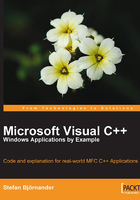
上QQ阅读APP看书,第一时间看更新
Chapter 1. Introduction to C++
C++ is a large object-oriented language that supports many modern features. As the name implies, it is a further development of the language C. In this chapter, you will learn the basics of the language. The next chapter deals with the object-oriented parts of C++. This chapter covers:
- An introduction to the languge, how the compiler and linker works, the overal structure of a program, and comments.
- C++ is a typed language, which means that every value stored in the computer memory is well defined. The type can be an integer, a real value, a logical value, or a character.
- An array is a sequence of values of the same type. Pointers and references hold the address of a value.
- In C++ there are possibilities to calculate values by using the four fundamental rules of arithmetic. We can also compare values as well as perform logical and bitwise operations.
- The flow of a program can be directed with statements. We can choose between two or more choices, repeat until a certain condition is fulfilled, and we can also jump to another location in the code.
- A function is a part of the code designed to perform a specific task. It is called by the main program or by another function. It may take input, which is called parameters, and may also return a value.
- The preprocessor is a tool that performs textual substitution by the means with macros. It is also possible to include text from other files and to include or exclude code.